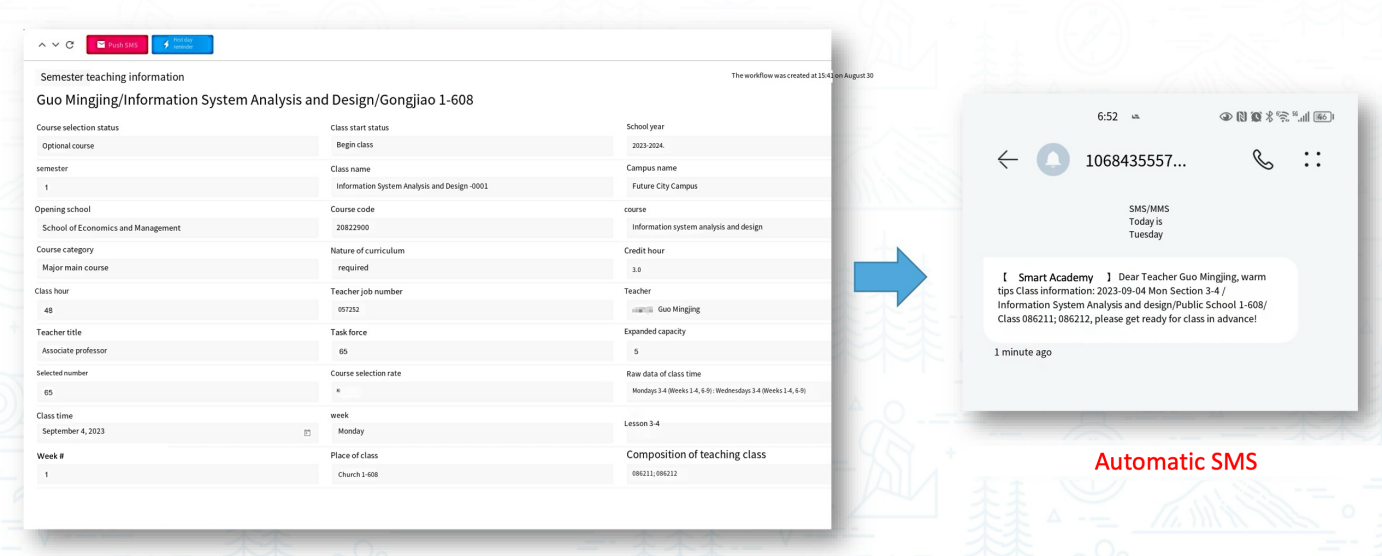
“Our educational philosophy needs to shift from a knowledge-based approach to a competency-based approach. I am willing to use Nocoly HAP to cultivate more outstanding digital talents for society.”
——Guo Mingjing, doctoral supervisor at China University of Geosciences
Summary
In today’s world, the importance of digital transformation in higher education is increasing, and digital transformation is a key breakthrough for the future development of universities. On the road of digital transformation in universities, data silos, heavy burden on teachers, and difficulty in meeting personalized needs of students are common pain points and challenges. China University of Geosciences(CUG) has effectively solved these problems by integrating data and flexibly developing six modules and more than ten applications through Nocoly HAP, promoting the digital transformation of the university, improving teaching quality and management efficiency, and providing a “CUG solution” for the digital transformation of Chinese universities.

Introduction
China University of Geosciences (CUG), established in 1952, is a national key university affiliated with the Ministry of Education. It is also listed in the National “211 Project” and the “Double First-class Plan”. CUG, featuring geosciences, is a comprehensive university that also offers a variety of degree programs in science, engineering, literature, management, economics, law, education and arts. Its Geology and Geological Resources & Engineering have both been ranked as national number one disciplines.
Challenges
Before using HAP, the School of Economics and Management at CUG faced the following problems and challenges:
Data silos abound, hindering information sharing
Although the internal data of the university is abundant, it is scattered among various systems and lacks effective integration and sharing mechanisms. This makes it difficult to obtain comprehensive and timely data support in the decision-making process, thereby affecting the accuracy and efficiency of management decisions. At the same time, teachers and students need to repeatedly enter personal information when using different systems, which not only increases the inconvenience of work and study, but also affects the consistency and accuracy of information. In order to enhance the rationality and effectiveness of management decisions, the school needs to break down data silos and achieve smooth flow and sharing of information.
Teachers have heavy workload and limited teaching energy
In daily teaching, teachers need to handle a large number of administrative tasks, such as attendance and grade entry. Although these tasks are important, they take up a lot of teachers’ time and energy, making it difficult for them to fully invest in teaching preparation and personalized guidance. At the same time, the process of exploring innovative teaching methods and educational practices also faces the challenge of technological barriers, such as difficult to use tools and low efficiency. To a certain extent, these have all affected the improvement of teaching quality and the deepening of teacher-student interaction. In order to stimulate teachers’ teaching enthusiasm and creativity, the school needs to reduce their administrative workload and allow them more time and energy to focus on teaching and student guidance.
Students passively accept and their individual needs need to be met
Under the traditional education model, students are often in a passive state of receiving knowledge, lacking initiative and a sense of participation. This limits their ability to fully utilize their learning outcomes and tap into their potential. Meanwhile, due to the singularity of course management and access to learning materials, it is difficult to meet the diverse learning needs of students. In order to enhance students’ learning experience and effectiveness, the school needs to pay attention to their personalized needs and provide them with more flexible and diverse learning resources and interactive platforms.
Solutions
In the context of the digital transformation of higher education in China, in order to enable students to “learn better”, teachers to “teach better”, and universities to “manage better” and “serve better”, CUG has carried out many practices using the HAP and proposed the “CUG solution”.
Data integration and information sharing
CUG has established more than ten applications in six major modules, including the Smart Academy, Training Internal Control, and Study and Research Team, through the HAP, achieving cross departmental data connectivity and real-time sharing. These systems not only integrate dispersed data resources, but also provide comprehensive data views for management to support more accurate management decisions. For example, multidimensional data analysis in systems provides strong data support for educational and teaching review and evaluation.

Teacher automation management tools
HAP has equipped teachers with a course management platform and automated management tools to address the heavy workload they face and its impact on teaching quality. These tools are designed to be simple, easy for teachers to quickly get started, and do not require a lot of time to learn and operate. With HAP, teachers can efficiently manage teaching resources, student information, and daily affairs, significantly reducing their workload. As a result, teachers are able to devote more energy to teaching and interacting with students, thereby improving the quality of teaching. In addition, the platform’s built-in online interactive function also promotes real-time communication between teachers and students, enhancing the interactivity of teaching.

Customized academic research teams and training platforms
To meet the personalized learning needs of students, CUG has carefully built management systems using HAP such as Study and Research Team and Training Platform. These applications not only give students the right to independently choose learning content and practical projects, stimulate their internal learning motivation, improve learning efficiency and quality, but also help students deeply explore their potential and achieve personalized growth through rich online resources and community interaction. More importantly, this series of measures greatly enhances students’ employment competitiveness and lays a solid foundation for their future careers.

In addition, HAP also provides rich application scenarios and tools for CUG, such as large screen display, data generation, forum poster production, etc., to support the diversified development needs. These practices have jointly promoted the digital transformation process of CUG, improving the quality of education and management efficiency.



